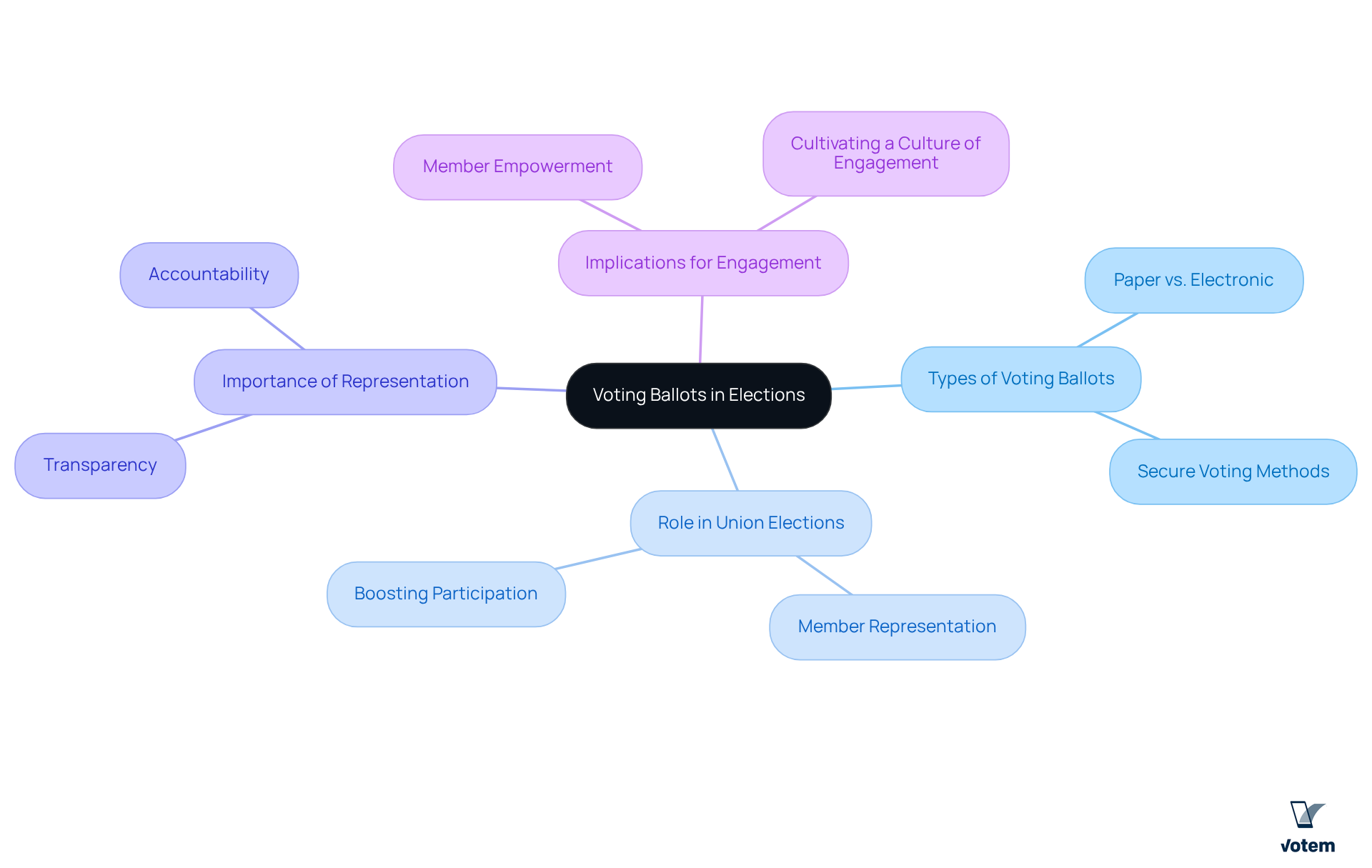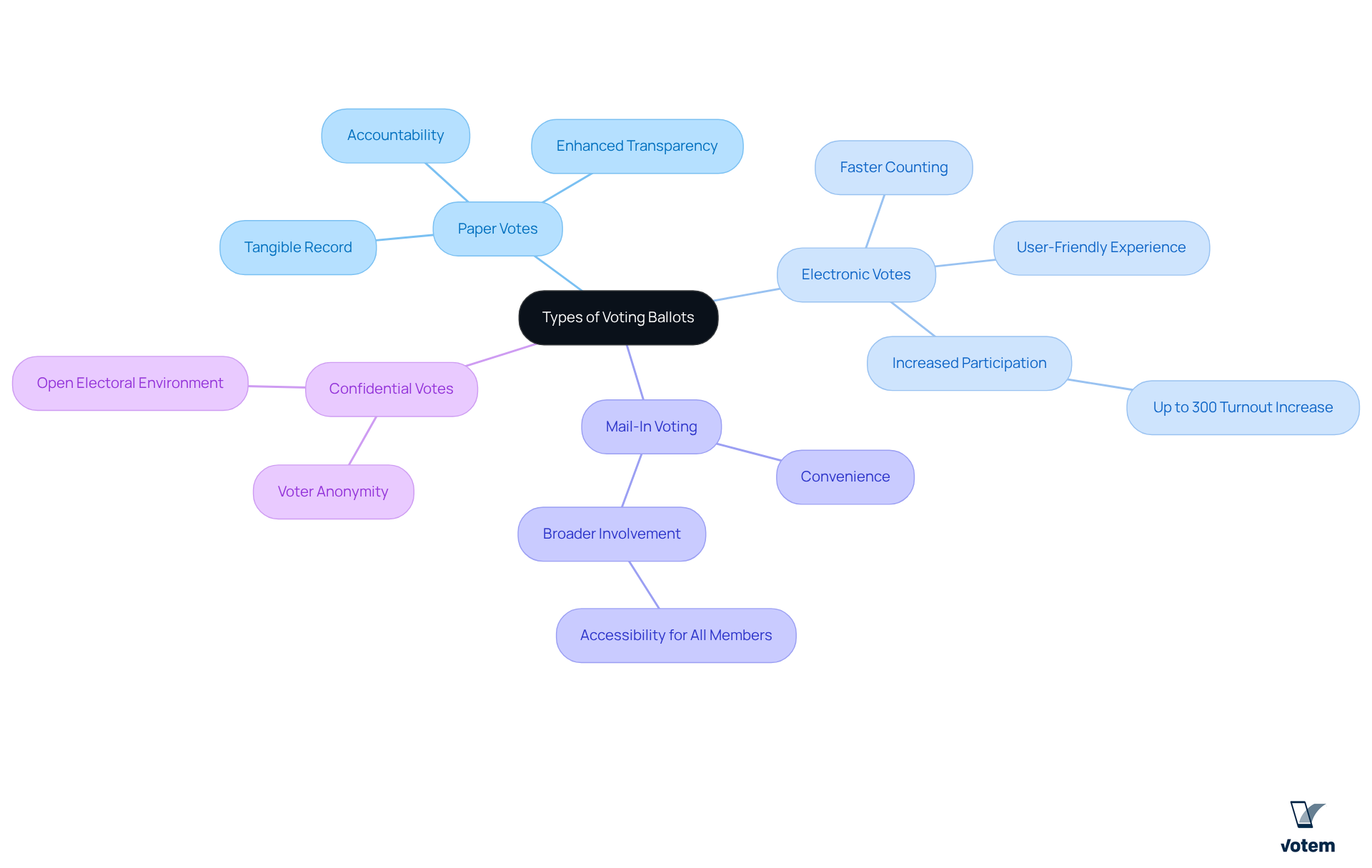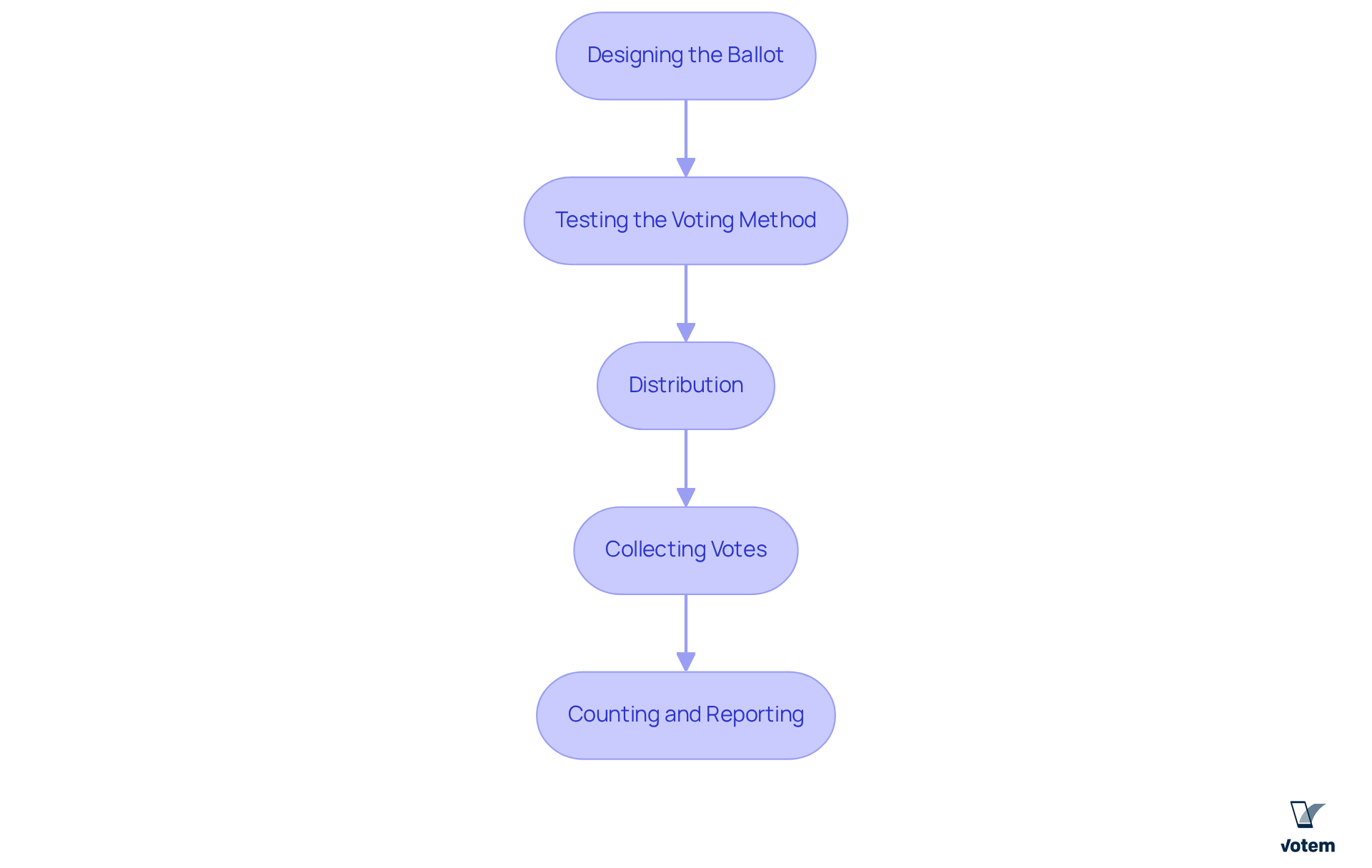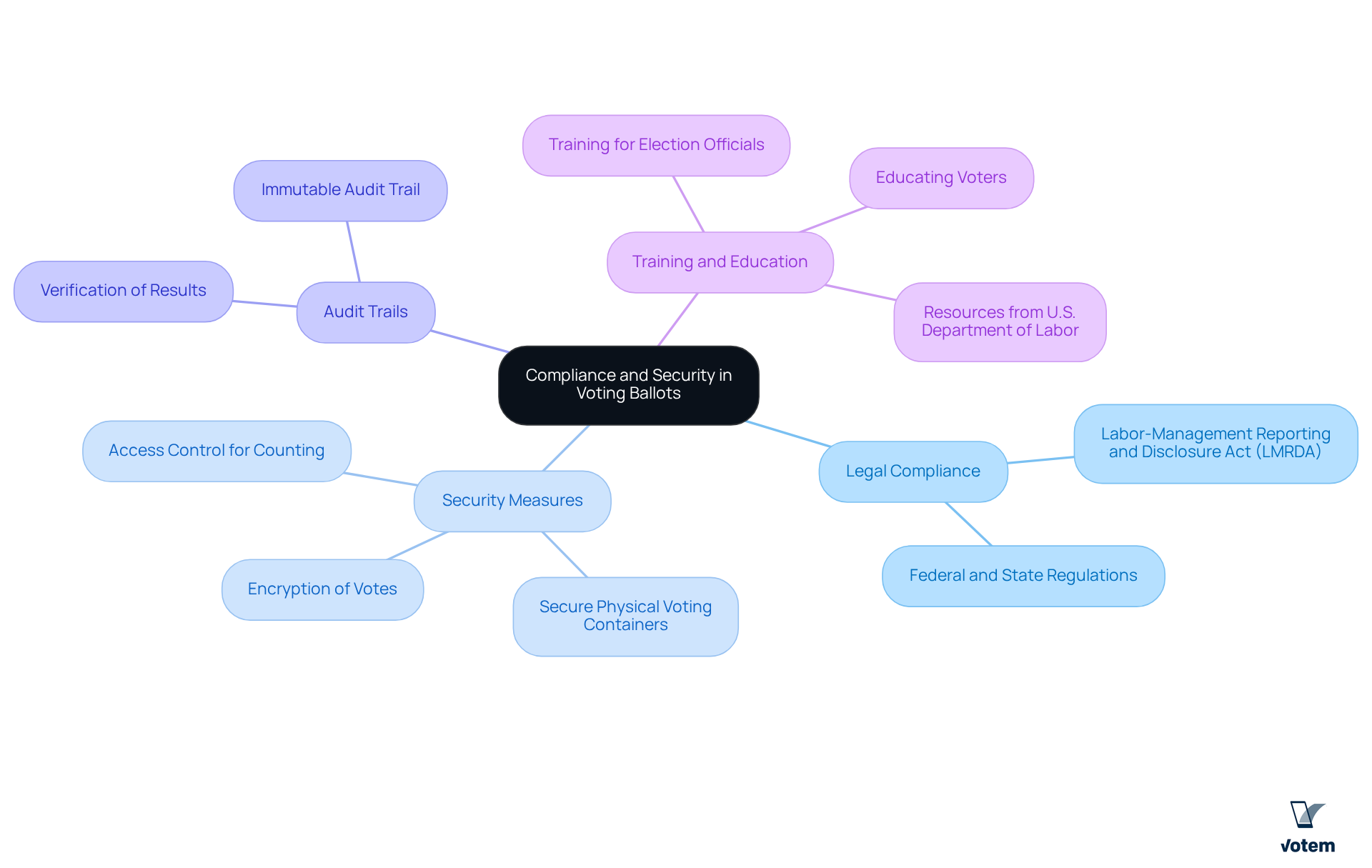Overview
The article examines four distinct types of voting ballots utilized in union elections:
- Paper votes
- Electronic votes
- Mail-in voting
- Confidential votes
Each of these ballot types plays a crucial role in enhancing voter participation and ensuring fair representation within the union. Understanding these ballot types is essential, as they significantly influence the electoral process by promoting transparency, accessibility, and security. Such factors are vital in fostering trust among union members and encouraging active engagement in the democratic process.
Furthermore, the implications of these voting methods extend beyond mere participation; they shape the overall integrity of the electoral system. By implementing diverse voting options, unions can address the varying needs of their members, thus increasing the likelihood of higher turnout rates. This not only empowers members but also strengthens the union’s collective voice in decision-making processes.
In conclusion, a comprehensive understanding of these voting ballot types is not just beneficial; it is imperative for union leadership. By prioritizing education on these methods, union leaders can cultivate an environment of trust and transparency, ultimately leading to a more engaged and representative membership.
Introduction
Voting ballots serve as the backbone of democratic processes, particularly in union elections where every member’s voice holds significant weight. By understanding the various types of voting ballots—spanning from traditional paper votes to modern electronic systems—union leaders can significantly influence voter participation and the overall integrity of the electoral process. Yet, how can these leaders ensure that these mechanisms not only uphold transparency and fairness but also actively engage all members in shaping their collective future?
Exploring the nuances of each ballot type reveals critical insights into enhancing electoral participation and fostering a culture of accountability within unions. Furthermore, it is essential to recognize that the effectiveness of these voting mechanisms directly impacts member engagement and trust in the union’s leadership. In addition, as union leaders navigate these complexities, they must consider strategies that not only inform but also empower members to take an active role in the electoral process.
Define Voting Ballots and Their Role in Elections
Voting papers, or types of voting ballots, serve as vital instruments within the electoral system, enabling voters to express their preferences for candidates or issues through both paper and electronic formats. In the context of union elections, these votes are essential for ensuring that every member’s voice is accurately represented and counted. Not only do they streamline the election process, but they also reinforce the principles of transparency and fairness—cornerstones for fostering trust within the union.
The integrity of the electoral process is significantly influenced by how types of voting ballots are utilized, highlighting the necessity for union leaders and members to understand their importance. By adopting secure and compliant electoral methods, unions can boost participation and uphold democratic values, ultimately leading to enhanced representation and accountability. Furthermore, as emphasized by various leaders, casting a ballot transcends mere rights; it embodies a responsibility that shapes the future of the organization and its members.
In addition, consider the implications of effective voting practices: they not only empower members but also cultivate a culture of engagement and accountability. How can union leadership ensure that every voice is heard? By prioritizing the electoral process, unions can transform participation into a powerful tool for change.

Explore Different Types of Voting Ballots
Union elections utilize various types of voting ballots, each offering unique advantages that can greatly impact voter participation and engagement.
-
Paper Votes serve as the traditional method, where voters mark their choices on paper, which are then collected for counting. This approach provides a tangible record of votes, enhancing transparency and accountability within the electoral process.
-
Electronic Votes are submitted through electronic devices, allowing for faster counting and a more user-friendly experience. The remote accessibility of electronic voting has been shown to boost electoral participation, with some organizations reporting turnout increases of up to 300% on launch day.
-
Mail-In Voting permits individuals to receive their ballots by post, enabling them to cast their votes at their convenience. This option is particularly beneficial for those unable to participate in face-to-face elections, thus promoting broader involvement across diverse member demographics.
-
Confidential Votes are crucial for protecting voter anonymity, essential in union elections. These votes safeguard members from potential repercussions based on their choices, fostering a more open and honest electoral environment.
By understanding these various election types and the different types of voting ballots, union leaders can select the most effective method for their decisions, ensuring that all members can engage fully and without restriction. The incorporation of electronic voting solutions, in particular, has proven successful in enhancing participation and engagement, thereby strengthening the democratic principles of union governance.

Understand Ballot Design and Implementation Processes
The design and implementation of ballots involve several critical steps to ensure a smooth electoral process:
-
Designing the Ballot: This phase focuses on creating a clear layout with legible fonts and straightforward instructions. Ballots should reduce confusion and enhance accessibility, following standards like WCAG 2.1 AA to guarantee inclusivity for everyone participating. Linda McCulloch observed that implementing Votem’s modern system provided greater access for all eligible individuals, including military personnel and those with disabilities, signifying a notable achievement in her office.
-
Testing the Voting Method: Conducting usability testing with a representative group of participants is essential before finalizing the voting document. This testing helps identify potential issues and gather feedback, which can refine the design for improved clarity and usability. Studies show that utilizing simple language in voting instructions greatly decreases mistakes made by participants, enhancing their capacity to cast their votes as desired. Furthermore, mobile voting initiatives have shown a rise in participation by three to five percentage points, highlighting the significance of usability testing in enhancing electoral turnout.
-
Distribution: Once the design of the voting paper is finalized, effective dissemination to all qualified participants is crucial. This can involve sending paper votes, providing electronic access, or establishing in-person voting locations to ensure that all participants can engage conveniently.
-
Collecting Votes: Establishing secure methods for gathering completed votes is paramount. Whether through drop boxes, mail, or electronic submission, ensuring the security of the ballot collection process is vital for maintaining public trust and confidence in the electoral system. Votem’s CastIron platform exemplifies this commitment, providing features that guarantee secure and accessible ballot casting. For instance, Votem successfully handled the receipt of 299,000 votes for the National Radio Hall of Fame, a significant increase from the previous year, showcasing how innovative solutions can enhance voter participation.
-
Counting and Reporting: After the election period concludes, accurate counting of ballots and transparent reporting of results to all stakeholders are essential. This procedure should incorporate an immutable audit trail to verify the integrity of the election results, fostering trust in the electoral system. The New Mexico State Republican Party was very pleased with the performance of Votem’s software, which they plan to use again for their upcoming elections, further illustrating the effectiveness of secure ballot methods in increasing participation.
By prioritizing usability testing and following these steps, unions can enhance voter engagement and ensure a more effective electoral process.

Ensure Compliance and Security in Voting Ballots
Ensuring compliance and security in types of voting ballots is paramount for union elections. Legal compliance is the first consideration; elections must adhere to federal and state regulations, including the Labor-Management Reporting and Disclosure Act (LMRDA). This guarantees that elections are conducted confidentially and that all members are informed of their rights to participate.
Next, implementing robust security measures is crucial to safeguarding the integrity of the electoral system. Votem’s innovative online voting solutions incorporate advanced security protocols, such as encrypting electronic votes and securing physical voting containers. These measures ensure that only authorized personnel have access to votes during the counting stage, reinforcing trust in the process.
Additionally, maintaining an immutable audit trail for all ballots cast is essential for transparency. This allows for the verification of results and fosters trust among union members. Votem’s systems are designed to deliver thorough audit trails, thereby enhancing the overall integrity of the election.
Finally, training election officials and educating voters are critical components of the electoral process. All individuals involved in election activities should receive instruction on compliance and security protocols, ensuring they understand their responsibilities and the significance of preserving election integrity. Moreover, providing clear information to citizens about how the types of voting ballots they receive will be managed and tallied can significantly enhance confidence in the electoral process. Votem emphasizes the importance of both training and electorate education, equipping election officials and citizens with the necessary resources to prevent errors and boost participation. This approach has proven effective, as evidenced by testimonials highlighting significant increases in voter turnout, demonstrating the impact of accessible and secure voting solutions.

Conclusion
Voting ballots are not merely tools for casting votes; they serve as the cornerstone of democratic engagement within union elections. By understanding the various types of voting ballots—paper, electronic, mail-in, and confidential—unions can appreciate their distinct advantages and the critical role they play in ensuring that every member’s voice is not only heard but also counted. Selecting the most appropriate ballot type enhances voter participation, promotes transparency, and upholds the democratic values essential to effective governance.
The importance of ballot design and implementation cannot be overstated. Clarity, security, and compliance with legal standards are paramount. Each step in the process, from designing the ballot to distributing and counting votes, is crucial for fostering trust and engagement among union members. Furthermore, incorporating robust security measures and maintaining an immutable audit trail solidifies the integrity of the electoral process, ensuring that members can confidently participate in shaping their union’s future.
Ultimately, the significance of voting ballots in union elections extends beyond mere participation; they are a means of empowerment and accountability. Union leaders are urged to prioritize the electoral process, leveraging the insights shared to create an inclusive environment where every member can actively contribute to their union’s direction. By doing so, unions not only enhance their democratic practices but also cultivate a culture of engagement that can drive meaningful change and strengthen the collective voice of their members.
Frequently Asked Questions
What are voting ballots and what role do they play in elections?
Voting ballots, or types of voting papers, are essential tools in the electoral system that allow voters to express their preferences for candidates or issues. They can be in both paper and electronic formats and are crucial for ensuring accurate representation and counting of votes in elections, particularly in union contexts.
Why are voting ballots important in union elections?
In union elections, voting ballots are vital for ensuring that every member’s voice is represented and counted. They help streamline the election process and reinforce transparency and fairness, which are essential for fostering trust within the union.
How do voting ballots influence the integrity of the electoral process?
The integrity of the electoral process is significantly affected by the utilization of voting ballots. Understanding their importance allows union leaders and members to adopt secure and compliant electoral methods, which can enhance participation and uphold democratic values.
What responsibilities come with casting a ballot?
Casting a ballot is not just a right but a responsibility that shapes the future of the organization and its members. It emphasizes the importance of participation in the democratic process.
How can effective voting practices benefit union members?
Effective voting practices empower union members and cultivate a culture of engagement and accountability. They ensure that every voice is heard, transforming participation into a powerful tool for change within the union.
What should union leadership prioritize to enhance participation?
Union leadership should prioritize the electoral process to ensure that all members can participate effectively, thereby enhancing representation and accountability within the union.
List of Sources
- Define Voting Ballots and Their Role in Elections
- These Inspiring Quotes Will Get You Excited to Vote (https://countryliving.com/life/g24446791/voting-quotes)
- Jesuit Resource – Election Day Quotes (https://xavier.edu/jesuitresource/online-resources/quote-archive1/election-dayvoting)
- 7 Strategies to Engage Union Voters Effectively | Online Voting with Votem® (https://votem.com/7-strategies-to-engage-union-voters-effectively)
- Explore Different Types of Voting Ballots
- 7 Benefits of Union Electronic Voting for Enhanced Participation | Online Voting with Votem® (https://votem.com/7-benefits-of-union-electronic-voting-for-enhanced-participation)
- Electing Union Officers Using Remote Electronic Voting Systems (https://dol.gov/agencies/olms/compliance-assistance/tips/remote-electronic-voting-systems)
- 7 Strategies to Engage Union Voters Effectively | Online Voting with Votem® (https://votem.com/7-strategies-to-engage-union-voters-effectively)
- Understand Ballot Design and Implementation Processes
- 10 Free Voting Apps to Boost Union Member Engagement | Online Voting with Votem® (https://votem.com/10-free-voting-apps-to-boost-union-member-engagement)
- 10 Voter Turnout Examples That Boost Engagement and Trust | Online Voting with Votem® (https://votem.com/10-voter-turnout-examples-that-boost-engagement-and-trust)
- How to Design Better Ballots (https://brennancenter.org/our-work/research-reports/how-design-better-ballots)
- Ensure Compliance and Security in Voting Ballots
- Electing Union Officers Using Remote Electronic Voting Systems (https://dol.gov/agencies/olms/compliance-assistance/tips/remote-electronic-voting-systems)
- How Secure Are U.S. Electronic Voting Systems? | Econofact (https://econofact.org/how-secure-are-u-s-electronic-voting-systems)
- New union election rules yield much quicker elections – McAfee & Taft (https://mcafeetaft.com/new-union-election-rules-yield-much-quicker-elections)
- 5 Strategies for Effective Election Compliance in Unions | Online Voting with Votem® (https://votem.com/5-strategies-for-effective-election-compliance-in-unions)
- Security Issues in Labor Union Voting – ElectionBuddy (https://electionbuddy.com/blog/2024/10/09/security-issues-in-labor-union-voting)

